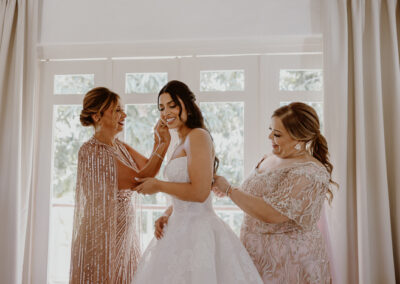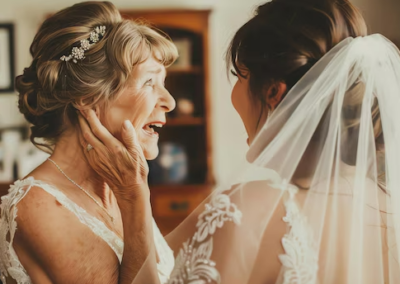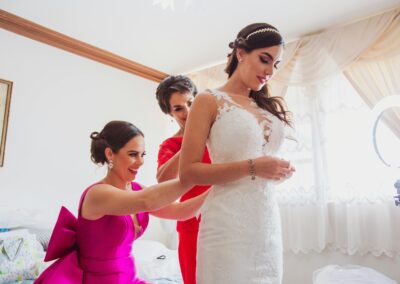How Much Should You Pay for a Wedding Dress?
When you’re planning a wedding, deciding how much to spend on a dress can be a challenging task. You might wonder if you should stick to the typical 10% of the total budget or let your heart lead you to a pricier gown. It’s essential to balance dreams with practicality, reflecting on the variety of options from budget-friendly to high-end. But what about those hidden costs, like alterations or accessories, that can quickly add up? There’s more to reflect on than just the price tag and understanding these factors can guide you towards making a wise investment.

Average Wedding Dress Costs
When planning for a wedding dress, it’s important to know the average costs to set a realistic budget. In bridal fashion, designer choices greatly impact price. Generally, wedding dresses range from $1,500 to $2,500, with many factors influencing these numbers. For budget-friendly options, you can find beautiful gowns under $500, while luxury and couture designers start at $2,000 and can climb to $20,000 or more. If you’re eyeing high-end designer names like Vera Wang, expect to pay upwards of $5,000. Alterations, a vital part of achieving the perfect fit, typically add $300 to $800 to your total. Understanding these averages helps you make informed bridal fashion decisions without overspending. It’s crucial to consider personal taste and priorities before finalizing the budget to avoid potential regret impacting future financial decisions. Choose wisely based on your style and budget.
Factors Influencing Price
Several key factors drive the price of a wedding dress and understanding them can help you make savvy budget decisions. Fabric choices greatly affect costs; high-end materials like silk, charmeuse, or imported Italian fabrics come with a premium price tag. The quantity needed for voluminous styles like ball gowns further increases the expense. Labor costs also play an essential role. Dresses crafted by skilled artisans, especially those with intricate designs or custom elements, require more time and expertise, pushing prices higher. Opting for dresses manufactured in countries with strict labor laws guarantees fair wages but can increase costs. The sentimental significance of wedding dresses often enhances their perceived worth, influencing how much brides are willing to spend. Balancing these elements with your budget will help you find a dress that meets both your style and financial expectations.
Tips for Budgeting
After understanding the factors that influence a wedding dress’s price, it’s important to focus on smart budgeting to confirm you get the most value for your money. Allocate about 10% of your total wedding budget for your dress, including alterations and accessories. Be aware of budgeting pitfalls like underestimating unexpected expenses such as taxes and shipping costs. Start shopping early to snag deals and confirm enough time for necessary alterations, which can add $200 to $600 to your budget. Consider budget-friendly options like off-the-rack dresses or rentals. Many brides opt to purchase their own dresses, reflecting a shift from traditional expectations where brides’ families would cover the cost. Tools like wedding budget advisors can help you outline and manage expenses effectively. Stick to simple designs to save on embellishments and remember to separate funds for accessories to avoid overspending.
Historical Pricing Trends
Although prices for wedding dresses have steadily increased over the years, understanding historical pricing trends can help you make informed choices and manage your budget effectively. Examining the pricing timeline, wedding dresses have seen considerable increases. In 2005, the average dress cost $678, jumping to $1,100 by 2016. By 2023, prices hovered around $2,000. This surge in historical prices is largely driven by supply chain delays, labor shortages, and rising material costs, such as lace and satin. Overseas production has also contributed to reduced American-made garments, impacting price dynamics. Wedding dresses, as high-ticket items, often experience annual increases of 5% to 10%. Considering these trends, you can anticipate potential price changes and plan accordingly. Keep regional variations in mind, as prices differ considerably between urban centers and rural areas.
Smart Shopping Strategies
Understanding historical pricing trends allows you to anticipate potential price changes, but smart shopping strategies can help you navigate these costs effectively. Start shopping 9-12 months before your wedding. This timeline gives you ample opportunity to explore diverse dress styles and avoid the premium of rush orders. Consider your venue, date, and season, as these elements influence your gown choice. Set a clear budget, typically 8-10% of your total wedding budget, including accessories and alterations. Research online and use social media for inspiration, focusing on dresses within your budget. Schedule appointments at reputable bridal shops and consider off-the-rack options. Keep an open mind and prioritize trying on various styles to find the perfect fit without overspending. Plan visits during quieter times at boutiques to receive more personalized attention and avoid crowd pressures.
Evaluating Dress Investment
Choosing the right wedding dress is not just about style; it’s a significant financial decision that requires careful consideration of various factors. Fabric type, intricate details, and designer reputation all affect the initial cost, while location and alterations add to the total. When evaluating dress investment, consider the dress resale potential. Dresses under two years old retain about 50% of their value, with famous designers reaching 60-70%. To maximize resale, sell soon after purchase. For budget-friendly options, explore off-the-rack or non-designer dresses. Remember, custom dresses can exceed $10,000, so plan accordingly. Use online tools to determine fair resale prices and be realistic; most used dresses go for $1,000 or less. Prioritize both style and investment value. Researching fabric types can help in understanding the price differentials and how they influence your overall budget.



